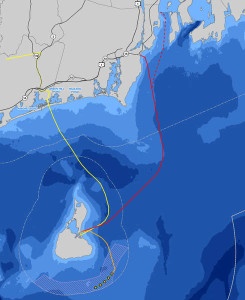We have much more to do and your continued support is needed now more than ever.
Little State Making Big Progress on Offshore Wind
Growing up in the Ocean State, I spent the majority of my summer by the beaches of Narragansett. My grandmother had a beach house on Great Island. From my grandmother’s beach house on Great Island we could just make out Block Island. I loved making the short drive from Galilee past Sand Hill Cove to Point Judith to see the light house, walk along the rocky peninsula, and hear the ocean surf crash all around us. It also offered up one of the best views of Block Island from shore.
When you come from the smallest state in the country, you tend to pay attention when your state starts making big news. For me, hearing that the offshore wind industry might be making its official jump start in Rhode Island is big news.
An offshore wind project called the Block Island Wind Farm is currently in the works and is slated to begin construction in 2013 or 2014. Compared to other utility scale projects being proposed along the Atlantic Coast, this proposed project is demonstration size. Only five offshore wind turbines are being developed and the project will be located just a few miles southeast of the island.

What’s so special about the Block Island Wind Farm?
For National Wildlife Federation, a promising component of this project is that it would be located in a site identified as appropriate for a renewable energy project by local, state, and federal stakeholders before the project officially applied for its permits. This has created a forum for wildlife and environmental impacts data and concerns to be discussed early on in the process to ensure that an appropriate location was chosen. Additionally, while three miles south of Block Island, the project is actually 13-16 miles from the mainland, and data collected by state and federal agencies and the wind developer indicates this location will avoid areas important to marine mammals, birds, bats, fisheries, and benthic habitat in order to minimize impacts.
Deepwater Wind, the project developer, announced in April that they will be using state of the art turbines developed by Siemans Energy to generate 6 megawatts of power each for this island. Typically most offshore wind projects being proposed have turbines that put out between 3 and 4 megawatts of power. These 5 new turbines can generate the same energy output as 7 or 8 typical turbines on other wind farms and do so with less impact to the surrounding ecosystem. This would be the first project in the U.S and one of the first anywhere in the world to make use of this new cutting edge technology.
For Block Island residents, switching to offshore wind is a no-brainer in my mind. The only way to supply energy for this small island is transport diesel fuel on tanker trucks via ferry. This gives Block Island one of the highest costs of electricity in the country. In 2009, residents on the island paid 49 cents per kilowatt hour, while their mainland neighbors only paid 15 cents per kilowatt hour. Offshore wind power could cut that price in half, making it much more competitive with mainland prices. On top of that, it takes roughly one million gallons of diesel fuel to power their generators. Burning all that diesel produces roughly 40,000 tons of carbon pollution every year. By making the change to offshore wind, Block Island residents would save money and help reduce carbon emissions contributing to climate change.
One of the main problems holding back offshore wind here in the U.S. is that there is not a single offshore wind turbine spinning anywhere in our waters. Getting even just one offshore wind turbine installed anywhere along the East Coast will be huge step for the industry. I may be a little biased, but I would be thrilled to have the first project get started in my home state. Growth in the clean energy industry will produce jobs that could even help with Rhode Island’s high rate of unemployment. Just look at what the clean energy industry has been doing for Massachusetts, right over the border.
The National Wildlife Federation believes that carbon pollution, and associated climate change, is the greatest threat facing wildlife today. We believe that offshore wind energy can and must be constructed and operated in a way that does not threaten our sensitive coastal and marine wildlife such as birds, sea turtles, and whales. NWF supports offshore wind in the Atlantic Ocean as a critical part of America’s clean energy future.





















